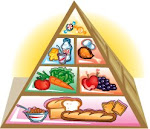Do you consider yourself a “healthy” eater but still feel like something is lacking in your diet? Perhaps you crave something sweet after eating an enormous vegetarian black bean burrito at the local Tex-Mex joint. Or you find yourself dozing off in the afternoon even though you opted for the veggie burger & steamed broccoli (instead of beef burger and fries) at lunch. Isn’t a vegetarian diet supposed to make you feel good? Aren’t we supposed to eat more fruits and vegetables?
Since entering the twenty-first century, a case can no longer be made for including French fries in one’s daily vegetable tally. However, the nutritional status of ketchup is still ambiguous in many people‘s minds. The bottle claims the condiment to be a good source of lycopene (a phytochemical shown to decrease the risk of certain cancers). If you were to slather a generous serving of the red stuff on your veggie burger, you’d meet 4% of the daily requirment for Vitamin C. Why shouldn’t that count? Assuming the trace amount of vitamins detectable in ketchup is significant, despite the high fructose corn syrup; then do you give yourself brownie points for eating a vegetable or a fruit (it tastes more like a fruit to me)?
Geez, what did people do before the invention of the mandatory Nutrition Facts label? They probably enjoyed their food a lot more and certainly didn’t suffer anxiety obsessing over healthy eating (not technically an eating disorder, the term given to the angst and extreme behavior evoked by trying to eat too healthfully - orthorexia, is currently being studied by clinicians and academics).
With so much evidence linking specific nutrients to the prevention of diseases like arthritis and diabetes, the delicate effects that food has on a person’s emotional and mental state is overlooked by researchers. Aside from the consequence that carbohydrates have on serotonin levels which in turn alters mood; mental well-being does not come up in discussions about eating to satisfy one’s nutritional needs. Sure, certain vitamins and fatty acids have been associated with decreased risk of developing mental disorders like Alzheimer’s disease. But the science is based on a strictly biomechanical understanding of the brain.
Ayurveda views the mind as a non-physical entity which is not confined to a single organ. In addition to determining a person‘s personality, the mind in a stream of consciousness that flows throughout the entire body and is altered by subtle qualities (so subtle that they can not be detected by conventional modern means) inherent in the Universe. These subtle qualities, or “essences”, also known as
gunas, exist in all things including edible substances. There are three
gunas: sattva, rajas and
tamas.
Sattva is the quality of purity, truth and light which promotes balance & spiritual development.
Rajas is the quality of activity and movement so leads to desires, passion and outward action.
Tamas is the quality of dullness, inertia and darkness that creates ignorance, lethargy or laziness.
While all three
gunas are necessary to some degree, Ayurveda emphasizes the cultivation of
sattva because it encourages a state of balance which ultimately facilitates healing. Yogis who aspire to higher levels of spiritual attainment also focus on a lifestyle and diet that is
sattvic in nature.
Sattvic foods, such as fresh fruits and vegetables, whole grains and high quality dairy products, are thought to have a rejuvenating effect on the body and calm the mind.
Typically, yogis eschew meat due to its mainly
tamasic quality which saps the body of energy and suppresses agni leading to the build up of toxins (
Ama).
Rajasic foods like onions, tomatoes and vinegar are also avoided because they are believed to encourage egotistical behavior, anger and jealosy.
A nutrition theory that truly appreciates the intimate connection between mind and body should therefore consider the influence of the
gunas. The
gunas help to explain certain paradoxes that exist with conventional thinking. Examining the inherent energetic qualities of Nature’s bounty also allows for a more individualized approach to diet. For instance, mushrooms are actually
tamasic, unlike most other vegetables which synthesize light and are therefore
sattvic. While a mushroom burger may not have the same effect on the arteries as one made with beef, it will leave the consumer with a similar dull feeling due to
tamas.
Let’s return to that black bean burrito. Why would a well-meaning omnivore leave the table desiring something sweet after polishing off a vegetarian menu item? Sure, black beans and most whole grains (we’ll assume that the restaurant offers whole wheat tortillas) are
sattvic. The onions, peppers, garlic, sour cream, guacamole (it’s made with avocadoes) also stuffed inside the burrito are
rajasic. The combination of all these ingredients could be over stimulating and cause the body to crave something which will calm the senses down. The perfect antidote would be some nice juicy
sattvic fruit or a sweet lassi.
Alternatively, if the burrito joint is of the “cheap” persuasion - which relies on canned beans, poor quality or previously frozen vegetables, refined white flour products and microwave ovens - you may be suffering from a
tamasic hangover. No matter how “healthy” the ingredient list, the poetic menu description is mere hyperbole and downright fraudulent if the food ultimately served is nuked, overcooked or leftover from the previous week. So the
gunas are key!
Sattvic foods include well-prepared whole grains, legumes (except for peanuts), nuts, seeds, fresh & dried fruits, leafy vegetables, root vegetables, honey, fresh dairy products and
ghee (see side bar for great source of top quality ghee).
Rajasic foods are onions, garlic, radishes, peanuts, eggs, caffeinated beverages, vinager and other fermented foods. In the short term, sugar is rajasic.
Tamasic foods include mushrooms, meat, fish and white flour. Sugar is tamasic in the long term. All deep-fried, microwaved, stale, leftover, frozen and overcooked food also take on a quality of tamas.



















